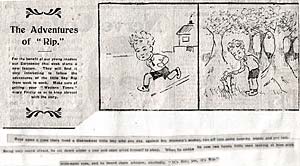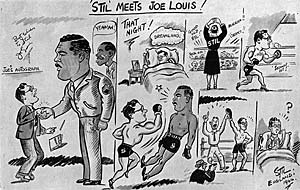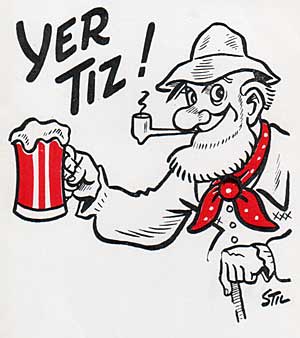
George 'Stil' Stillings - 1907 to 1967
Return to Exeter People Menu
Also see
Stil - the blitz
Stil - GIs in Exeter
Cartoons by Stil
The cartoon book 'Any Gum Chum' is remembered with affection by many, including thousands of elderly Americans who were young GIs based in Exeter, in the months before D-Day. The author, George Stillings went on to produce many cartoons and artwork for local businesses, the Express and Echo and even a weekly cartoon for the News of the World.
George Stillings was born in 1907 to George Dampier Stillings and Elizabeth nee Chamberlain. His father would busk in the seaside towns of Devon, including Lynmouth during the summer, and study and write music in the winter months. His family were often involved in the busking shows, and the young George was quickly involved, finding a talent for entertaining.
The family moved to Plymouth, and George was sent to the St James' the Great School, Plymouth. He gained a reputation for his cartoon doodles in the margin of his exercise books, drawing characters of his friends and teachers to, almost, everyone's delight. Once he was called to the headmasters office, where he was presented with a drawing set with the words "Although we are keen to see you get on as an artist, we do wish you wouldn't scribble all over your exercise books!"
An early start
In 1920, when at the age of 13, his father sent one of his drawings to the "Western Evening Herald" in Plymouth, who promptly published it – he would become a regular contributor to the newspaper into the 1930s. His work was soon noticed and he was commissioned to do a series of sketches for the local football ground, becoming known as "The Cartoon Kid". George Stilling was torn between entertaining and his cartoon work – at the age of 14 he found a solution when he first 'performed' his cartooning with lighting sketches, accompanied by a pianist. In 1924, the Western Times commissioned him to illustrate a serial written by the paper's sub-editor, E R Griffith. Entitled 'The Adventures of Rip', the series ran for several months as a strip cartoon.
As he became better known, George Stilling became 'Stil' and attracted much freelance work producing caricatures of local rugby, cricket and golf players – he became a regular contributor to the Western Morning News during the 1930s. His cartoons, often published on the front page, would be an instant report of a rugby or cricket match that had taken place that weekend. He also produced similar work when Exeter Airport was opened and on other occasions. He moved to working for the Express and Echo and became well known around the city as he rode his Brough Superior motorcycle, often with a reporter riding pillion.
The War Years
When war broke out in 1939, George wanted to join up and become a soldier or airman, seasickness putting him off the navy. Unfortunately, the medical board decided he was not fit for duty. Wanting to 'do his bit' he devised a lightning sketch act and auditioned for ENSA, the services entertainment organisation. His act would be accompanied by a pianist playing such songs as "Whose Afraid of the Big, Bad Wolf?" for Hitler, "Roll out the Barrel" for Goering, and the "Donkey's Serenade" for "Lord Haw-Haw". He toured service camps around the country, performing on improvised stages, sometimes interrupted by an air raid. During the May 1942 blitz of Exeter, George sheltered in the underground passages, while the Eastgate Arcade collapsed above him – when eventually he, along with the others sheltering from the raid, emerged, he discovered his office in Northernhay Place had been destroyed, along with his cartoon archive. His blitz memories are a fascinating look at what it was really like.
When the Americans entered the war, George became attached to the American Red Cross Service Club and often performed his act at the city's Mardon Hall. He became very friendly with many GIs during their stay and was often invited out to parties at the various air bases around Exeter. It was during this period that his astute observation of Americans interacting with the locals, led to his book 'Any Gum Chum', an affectionate, and often naughty, look at life around Exeter with the occupying GIs. In 1944, he met Joe Louis, the American boxer who was on a tour of U.S. bases. He did a sketch of him which he autographed. George claimed that his hand ached for several years after he shook his hand.
He wrote of his memories of the Yanks "I have found that one of the characteristics of the American people is the wholehearted ability to laugh at their own expense and I am confident that these cartoons will be accepted in the spirit in which they are meant. The Yanks are a warm-hearted lot and, speaking as an Englishman, it is my sincere hope that the great spirit of good fellowship which now exists between America and Britain will never be broken."
Stil's follow up book 'More Gum Chum' ran into trouble in July 1945 when the Sunday Pictorial published a piece claiming 'This book is disgusting', after a complaint from British troops serving abroad, who believed it was insulting to the women at home. George withdrew the book, but soon, letters from other British servicemen around the world flooded into the Sunday Pictorial and to George, supporting his book. One soldier wrote "… I fail to agree with your headline, 'This Book is Disgusting' and furthermore, I consider the remarks of our Eighth Army friend to be grossly unfounded." Another wrote "The rest of the boys are so busy writing to our favourite Sunday Paper, telling the Editor that it's the first time they've ever disagreed with him." Stil published the 'No Gum Chum' VE edition to celebrate the end of hostilities in Europe.
The News of the World
After the war, George Stillings was joined by his brother Harry in an advertising studio based in Longbrook Street. From 1946 to 1949 he produced a weekly pocket cartoon for the News of The World, while providing cartoons for the local Express and Echo, publishing cartoon books about city life, and illustrating many adverts for local businesses, often with a caricature of the owner. The black market of the wartime years evolved into theworld of the 'spiv', who took advantage of the shortages to make a quick, and often illegal profit. This was a goldmine of material for jokes and social comment, which often permeated his work.
In 1952 he produced the programme for Lammas Fair, and was also producing cartoons for the Theatre Royal programme. He and his brother published a series of advertising booklets promoting local pubs and hotels, all illustrated with his inimitable cartoons. It was during the 1950s that Still copyrighted one of his most well known characters, 'Old Garge' a Devon local, accompanied by is dog 'ol dummon Liz'. This character, first developed just after the war, became well known by many visitors to the Devon seaside resorts as a series of Greetings from Devon cartoon postcards warning of the dangers of the local 'rough zider' and the telling tourist that 'Yu' can't miss it! 'Tiz bout vour miles further on as craw vlies'
George Stilling once said that he liked to draw from observation – he didn't like drawing women, because it was a bald head or bushy moustache that gave him a starting point for a caricatures. His health in his last years was poor, although he still kept his observational hand in – George Stillings died in September 1967.
Sources: George Stillings archive kindly provided by his daughter Georgia Shorrock, the Western Times and the Express and Echo.
 George Stilling in his studio. Click to enlarge.
George Stilling in his studio. Click to enlarge. 'The Adventures of Rip' from 1924.
'The Adventures of Rip' from 1924. Stil meets Joe Louis. Click to enlarge.
Stil meets Joe Louis. Click to enlarge.
 Possibly Stil's most famous creation, 'Ol Garge'.
Possibly Stil's most famous creation, 'Ol Garge'.
│ Top of Page │